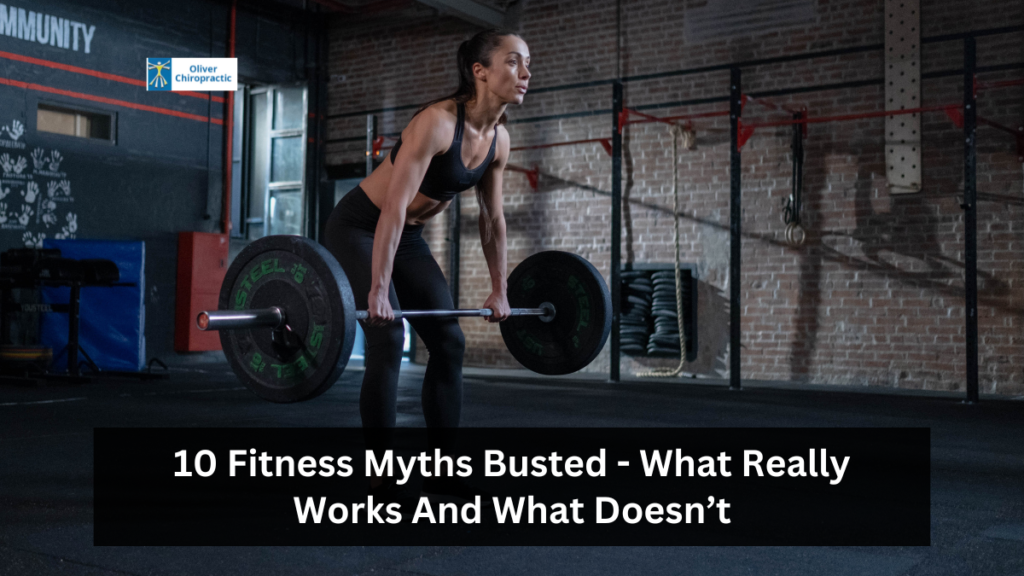Numerous myths and misconceptions cloud the path to achieving optimal well-being in health and fitness. These myths can lead individuals astray, causing frustration and hindering progress. This article debunks ten common fitness myths, clarifying what truly contributes to a healthy lifestyle.
1. Spot Reduction Is Effective
The belief that exercising specific body parts can lead to fat loss in those areas is widespread. However, fat loss occurs uniformly across the body, not in isolated regions.
Exercises like sit-ups or leg lifts will strengthen the targeted muscles but won’t specifically burn fat in those areas. Fat reduction is achieved through cardiovascular exercises, strength training, and a balanced diet.
2. Lifting Weights Make Women Bulky
A common misconception is that women who lift weights will develop large, bulky muscles. This is largely due to hormonal differences. Women have significantly lower levels of testosterone than men, making it challenging to gain substantial muscle mass.
Incorporating weightlifting into a fitness routine enhances strength, tones muscles, and boosts metabolism without leading to excessive bulk.
3. Cardio, Best Way To Lose Weight
While cardiovascular exercises are practical for burning calories, relying solely on them for weight loss is insufficient.
Strength training is crucial in building muscle mass and increasing resting metabolic rate, leading to more calories burned even at rest. A balanced fitness regimen, including cardio and strength training, is essential for weight management.
4. Stretching Before Exercise Prevents Injuries
Many believe that static stretching before a workout prevents injuries. However, research indicates that static stretching can temporarily decrease muscle strength and may not effectively prevent injuries.
Dynamic warm-ups, such as leg swings or arm circles, are more beneficial in preparing the body for exercise and reducing injury risk.
5. More Sweat Means Better Workout
The sweat produced during exercise does not accurately indicate workout intensity or effectiveness.
Sweating is the body’s primary mechanism for regulating temperature, and it varies based on individual factors like genetics, hydration levels, and environmental conditions. Focusing on the quality and consistency of workouts is more important than the quantity of sweat produced.
6. No Pain, No Gain
The notion that experiencing pain during or after a workout signifies effectiveness is misleading. While some muscle soreness can be expected, sharp or persistent pain is a warning sign of potential injury. It’s crucial to listen to the body and differentiate between discomfort from exertion and pain from injury.
7. Supplements Are Necessary for Muscle Growth
The supplement industry often promotes products as essential for muscle growth and recovery. However, a well-balanced diet rich in whole foods can provide all the necessary nutrients for muscle development. Supplements may be beneficial in certain situations but are not a substitute for proper nutrition.
8. Crunches Are Best Way To Get Flat Stomach
Performing numerous crunches will strengthen abdominal muscles but won’t specifically reduce belly fat. Achieving a flat stomach requires overall fat loss through cardiovascular exercises, strength training, and dietary modifications.
9. Women Should Avoid Heavy Weights
There’s a misconception that women should avoid lifting heavy weights to prevent becoming too muscular. In reality, lifting heavy weights benefits women, enhancing strength, bone density, and metabolism. The fear of bulking up is unfounded due to hormonal differences.
10. Exercising Can Compensate For Poor Diet
While regular exercise is vital for health, it cannot compensate for a poor diet. Nutrition plays a significant role in achieving fitness goals. A balanced diet supports energy levels, muscle recovery, and overall well-being, making it an integral component of any fitness regimen.
Dispelling these common fitness myths is essential for adopting effective and safe exercise practices. Understanding the truths behind these misconceptions empowers individuals to make informed decisions, leading to more successful and sustainable health and fitness journeys.
FAQs
1. Is It Possible To Lose FaIn Specific Areas Of The Body?
No, spot reduction is a myth. Fat loss occurs uniformly across the body, and targeted exercises strengthen muscles without specifically burning fat in those areas.
2. Will Lifting Weights Make Women Bulky?
No, women are unlikely to develop bulky muscles from weightlifting due to lower testosterone levels. Instead, it helps to tone muscles and boost metabolism.
3. Is Cardio The Most Effective Way To Lose Weight?
While cardio is beneficial, combining it with strength training is more effective for weight loss, as it builds muscle mass and increases resting metabolic rate.
4. Does Stretching Before Exercise Prevent Injuries?
Static stretching before exercise may not prevent injuries. Dynamic warm-ups are more effective in preparing the body for physical activity.
5. Can Supplements Replace A Balanced Diet For Muscle Growth?
Supplements can aid muscle growth but are not a substitute for a balanced diet. Whole foods provide essential nutrients necessary for muscle development.



